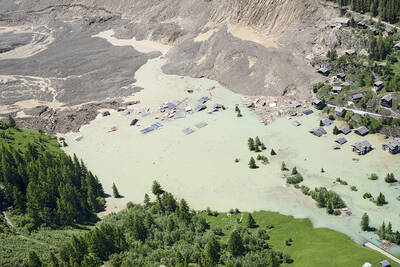US Defense Secretary Robert Gates said on Friday that the new missile defense system planned for Europe has the flexibility to adapt to changes in Iranian missile capabilities even if US intelligence about Tehran’s pace of development proves wrong.
US President Barack Obama’s decision to scrap the previous administration’s missile intercept system in Europe was based largely on a new US intelligence assessment that Iran’s effort to build a nuclear-capable, long-range missile would take three years to five years longer than originally thought, officials said earlier.
Gates, a former CIA director, said that even if Iran moves more quickly on its long-range missile program, the revised program will have the flexibility to deal more quickly and effectively with the change.
“We actually are better able to deal with a changed situation, in which the intelligence assessments are wrong, with the new architecture than we were with the old one,” Gates told reporters.
The new assessment asserts Iran is unlikely to have a nuclear-capable intercontinental ballistic missile (ICBM) until 2015 to 2020, a US government official familiar with the report said. The official spoke on condition of anonymity because the report remains classified.
It is the second time in two years that US intelligence has revised downward the threat posed by Iran’s weapons programs.
Obama abruptly canceled on Thursday a long-planned missile shield for Eastern Europe, replacing the Bush-era project that was strongly opposed by Russia with a plan the president contended would defend better against a growing threat of Iranian missiles.
The US no longer will seek to erect a missile base and radar site in Poland and the Czech Republic, virtually on Russia’s doorstep. Former US president George W. Bush contended that the missile base was needed to shoot down any Iranian missile — if it ever developed one with adequate range to threaten the US or Europe. The US already has a similar missile site and radar in Alaska.
Previous intelligence assessed that Iran would have an ICBM capable of menacing Europe and the US between 2012 and 2015, another US government official said.
The assessment changed because Iran has not been conducting the kind of observable development and testing that would be expected to accompany a robust long-range missile program, the second official said.
The new assessment is contained in a classified May 2009 National Intelligence Estimate. The secret report is called Foreign Ballistic Missile Development and Threat Through 2020.
National Intelligence Estimates contain the consensus judgment of all 16 US intelligence agencies about critical national security issues.
Thomas Fingar, former chairman of the National Intelligence Council, said Iran’s progress, or lack thereof, on its ballistic missile program can be observed easily.
“There’s been a lot of testing. They learned from the tests and we learned from the tests,” Fingar said.
Fingar, who spearheaded the controversial 2007 national intelligence estimate that disclosed Iran had halted its nuclear weapon design work in 2003, was not privy to the new intelligence.
But he said Iran may be working on short-range missiles because they are easier to build than large, long-range missiles, and lessons learned in their development can be applied to larger missiles.
He also said Iran may not be aggressively pursuing an ICBM because it has discerned its most likely adversaries are in the region, so shorter missiles have more immediate utility for offensive attacks or deterrence.
The new Obama plan would deploy systems designed to shoot down short and medium-range missiles, with construction in phases to begin around 2011. Systems to counter longer-range missiles would be in place around 2020.

Four people jailed in the landmark Hong Kong national security trial of "47 democrats" accused of conspiracy to commit subversion were freed today after more than four years behind bars, the second group to be released in a month. Among those freed was long-time political and LGBTQ activist Jimmy Sham (岑子杰), who also led one of Hong Kong’s largest pro-democracy groups, the Civil Human Rights Front, which disbanded in 2021. "Let me spend some time with my family," Sham said after arriving at his home in the Kowloon district of Jordan. "I don’t know how to plan ahead because, to me, it feels

Poland is set to hold a presidential runoff election today between two candidates offering starkly different visions for the country’s future. The winner would succeed Polish President Andrzej Duda, a conservative who is finishing his second and final term. The outcome would determine whether Poland embraces a nationalist populist trajectory or pivots more fully toward liberal, pro-European policies. An exit poll by Ipsos would be released when polls close today at 9pm local time, with a margin of error of plus or minus 2 percentage points. Final results are expected tomorrow. Whoever wins can be expected to either help or hinder the

North Korea has detained another official over last week’s failed launch of a warship, which damaged the naval destroyer, state media reported yesterday. Pyongyang announced “a serious accident” at Wednesday last week’s launch ceremony, which crushed sections of the bottom of the new destroyer. North Korean leader Kim Jong-un called the mishap a “criminal act caused by absolute carelessness.” Ri Hyong-son, vice department director of the Munitions Industry Department of the Party Central Committee, was summoned and detained on Sunday, the Korean Central News Agency (KCNA) reported. He was “greatly responsible for the occurrence of the serious accident,” it said. Ri is the fourth person

The collapse of the Swiss Birch glacier serves as a chilling warning of the escalating dangers faced by communities worldwide living under the shadow of fragile ice, particularly in Asia, experts said. Footage of the collapse on Wednesday showed a huge cloud of ice and rubble hurtling down the mountainside into the hamlet of Blatten. Swiss Development Cooperation disaster risk reduction adviser Ali Neumann said that while the role of climate change in the case of Blatten “still needs to be investigated,” the wider impacts were clear on the cryosphere — the part of the world covered by frozen water. “Climate change and